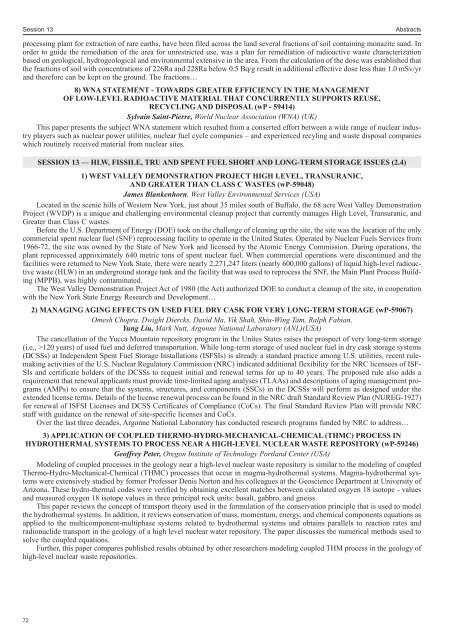ICEM11 Final Program 9.7.11pm_ICEM07 Final Program ... - Events
ICEM11 Final Program 9.7.11pm_ICEM07 Final Program ... - Events
ICEM11 Final Program 9.7.11pm_ICEM07 Final Program ... - Events
Create successful ePaper yourself
Turn your PDF publications into a flip-book with our unique Google optimized e-Paper software.
Session 13 Abstracts<br />
processing plant for extraction of rare earths, have been filed across the land several fractions of soil containing monazite sand. In<br />
order to guide the remediation of the area for unrestricted use, was a plan for remediation of radioactive waste characterization<br />
based on geological, hydrogeological and environmental extensive in the area. From the calculation of the dose was established that<br />
the fractions of soil with concentrations of 226Ra and 228Ra below 0.5 Bq/g result in additional effective dose less than 1.0 mSv/yr<br />
and therefore can be kept on the ground. The fractions…<br />
8) WNA STATEMENT - TOWARDS GREATER EFFICIENCY IN THE MANAGEMENT<br />
OF LOW-LEVEL RADIOACTIVE MATERIAL THAT CONCURRENTLY SUPPORTS REUSE,<br />
RECYCLING AND DISPOSAL (wP - 59414)<br />
Sylvain Saint-Pierre, World Nuclear Association (WNA) (UK)<br />
This paper presents the subject WNA statement which resulted from a conserted effort between a wide range of nuclear industry<br />
players such as nuclear power utilities, nuclear fuel cycle companies – and experienced recyling and waste disposal companies<br />
which routinely received material from nuclear sites.<br />
SESSION 13 — HLW, FISSILE, TRU AND SPENT FUEL SHORT AND LONG-TERM STORAGE ISSUES (2.4)<br />
1) WEST VALLEY DEMONSTRATION PROJECT HIGH LEVEL, TRANSURANIC,<br />
AND GREATER THAN CLASS C WASTES (wP-59048)<br />
James Blankenhorn, West Valley Environmental Services (USA)<br />
Located in the scenic hills of Western New York, just about 35 miles south of Buffalo, the 68 acre West Valley Demonstration<br />
Project (WVDP) is a unique and challenging environmental cleanup project that currently manages High Level, Transuranic, and<br />
Greater than Class C wastes<br />
Before the U.S. Department of Energy (DOE) took on the challenge of cleaning up the site, the site was the location of the only<br />
commercial spent nuclear fuel (SNF) reprocessing facility to operate in the United States. Operated by Nuclear Fuels Services from<br />
1966-72, the site was owned by the State of New York and licensed by the Atomic Energy Commission. During operations, the<br />
plant reprocessed approximately 640 metric tons of spent nuclear fuel. When commercial operations were discontinued and the<br />
facilities were returned to New York State, there were nearly 2,271,247 liters (nearly 600,000 gallons) of liquid high-level radioactive<br />
waste (HLW) in an underground storage tank and the facility that was used to reprocess the SNF, the Main Plant Process Building<br />
(MPPB), was highly contaminated.<br />
The West Valley Demonstration Project Act of 1980 (the Act) authorized DOE to conduct a cleanup of the site, in cooperation<br />
with the New York State Energy Research and Development…<br />
2) MANAGING AGING EFFECTS ON USED FUEL DRY CASK FOR VERY LONG-TERM STORAGE (wP-59067)<br />
Omesh Chopra, Dwight Diercks, David Ma, Vik Shah, Shiu-Wing Tam, Ralph Fabian,<br />
Yung Liu, Mark Nutt, Argonne National Laboratory (ANL)(USA)<br />
The cancellation of the Yucca Mountain repository program in the Unites States raises the prospect of very long-term storage<br />
(i.e., >120 years) of used fuel and deferred transportation. While long-term storage of used nuclear fuel in dry cask storage systems<br />
(DCSSs) at Independent Spent Fuel Storage Installations (ISFSIs) is already a standard practice among U.S. utilities, recent rulemaking<br />
activities of the U.S. Nuclear Regulatory Commission (NRC) indicated additional flexibility for the NRC licensees of ISF-<br />
SIs and certificate holders of the DCSSs to request initial and renewal terms for up to 40 years. The proposed rule also adds a<br />
requirement that renewal applicants must provide time-limited aging analyses (TLAAs) and descriptions of aging management programs<br />
(AMPs) to ensure that the systems, structures, and components (SSCs) in the DCSSs will perform as designed under the<br />
extended license terms. Details of the license renewal process can be found in the NRC draft Standard Review Plan (NUREG-1927)<br />
for renewal of ISFSI Licenses and DCSS Certificates of Compliance (CoCs). The final Standard Review Plan will provide NRC<br />
staff with guidance on the renewal of site-specific licenses and CoCs.<br />
Over the last three decades, Argonne National Laboratory has conducted research programs funded by NRC to address…<br />
3) APPLICATION OF COUPLED THERMO-HYDRO-MECHANICAL-CHEMICAL (THMC) PROCESS IN<br />
HYDROTHERMAL SYSTEMS TO PROCESS NEAR A HIGH-LEVEL NUCLEAR WASTE REPOSITORY (wP-59246)<br />
Geoffrey Peter, Oregon Institute of Technology Portland Center (USA)<br />
Modeling of coupled processes in the geology near a high-level nuclear waste repository is similar to the modeling of coupled<br />
Thermo-Hydro-Mechanical-Chemical (THMC) processes that occur in magma-hydrothermal systems. Magma-hydrothermal systems<br />
were extensively studied by former Professor Denis Norton and his colleagues at the Geoscience Department at University of<br />
Arizona. These hydro-thermal codes were verified by obtaining excellent matches between calculated oxgyen 18 isotope - values<br />
and measured oxygen 18 isotope values in three principal rock units: basalt, gabbro, and gneiss.<br />
This paper reviews the concept of transport theory used in the formulation of the conservation principle that is used to model<br />
the hydrothermal systems. In addition, it reviews conservation of mass, momentum, energy, and chemical components equations as<br />
applied to the multicomponent-multiphase systems related to hydrothermal systems and obtains parallels to reaction rates and<br />
radionuclide transport in the geology of a high level nuclear water repository. The paper discusses the numerical methods used to<br />
solve the coupled equations.<br />
Further, this paper compares published results obtained by other researchers modeling coupled THM process in the geology of<br />
high-level nuclear waste repositories.<br />
72
















